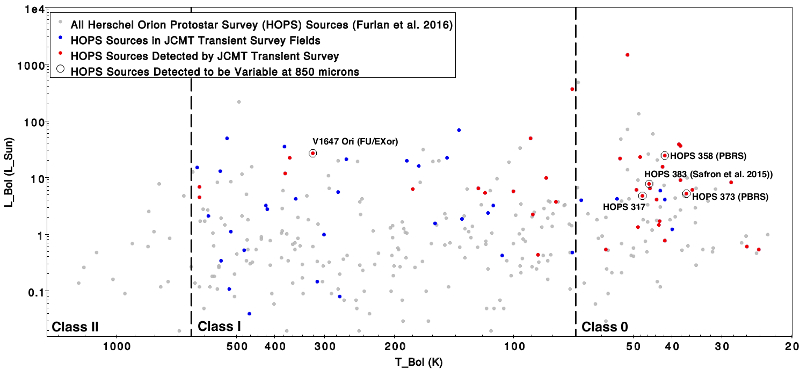
|
EPoS |
|
EPoS Contribution
|
|
The Dynamic Evolution of Protostars on Few Year Timescales
Doug Johnstone NRC-Herzberg, Victoria, CA | |
|
After four years of monitoring deeply embedded protostars in the sub-mm, the JCMT Transient Survey has uncovered over two dozen variable sources, corresponding to 30% of the brightest protostars. Period-fitting analyses find that a significant fraction of these protostars are associated with timescales of 3-8 years and fractional sub-mm amplitudes of 5-50%. We compare the strength of variability in the sub-mm with simultaneous observations at near-/mid-IR wavelengths for half our sample, revealing excellent light curve agreement. Expressed in magnitudes, the strength of the variability signal is found to be 4-6 times larger in the IR, confirming our expectation that the sub-mm emission is directly related to the changing dust temperature in the enveloping core while the IR responds to the changing source luminosity.
Assuming that the observed changes in brightness are due to time-variable accretion onto the protostar, the measured timescales and amplitudes suggest that dynamic processes taking place within the inner, several AU, protostellar disk play a role in modulating the mass assembly of deeply embedded protostars. Furthermore, combining the observed time-varying SEDs of these sources with radiative transfer models and with high-resolution ALMA imaging yields discriminatory information for the envelope, disk, and outflow cavity, breaking some of the degeneracy found when fitting static SEDs. Finally, we use ancillary information on the evolutionary stages of protostars in Orion to compile a census of which sources are most likely to be varying. | |
 | |
| Caption: Bolometric Luminosity versus Bolometric Temperature for the Herschel Orion Protostar Survey sources (grey dots; Furlan et al. 2016) overlaid with red (blue) dots indicating those sources that lie within the three JCMT Transient Survey Orion fields and are observed in the sub-mm (or not). The five sub-mm variables uncovered by the JCMT Transient Survey are marked with circles and labelled. Two of these five sources were previously known variables at other wavelengths and another two belong to the district sub-class of PACS Bright Red Sources (PBRS; Stutz et al. 2013). | |
| Collaborators: JCMT Transient Survey Team |
Key publication
Suggested Session: Cores |